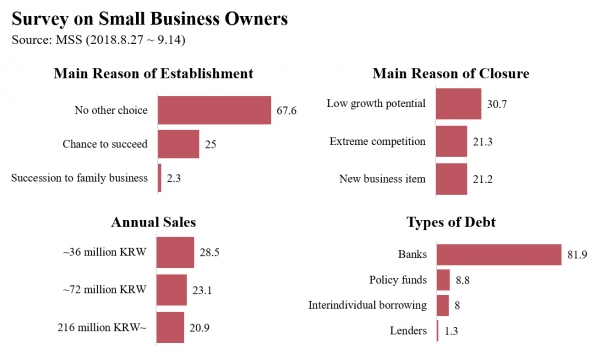
According to research from the Ministry of SMEs and Startups (MSS), there are 5.64 million self-employed people in Korea. This is 21.0% of total employees, and the figure has decreased since 2008 when it was 25.3%. The ratio is quite high compared to those of OECD countries. In 2017, 25.4% of the total employees were self-employed and this is the fifth highest among OECD countries: unlike domestic figures, it counted unpaid family workers as self-employed people. Another report of the MSS claims that 67.6% of self-employed people started their businesses ‘because there was no other choice other than establishment’. In other words, most self-employed people established their businesses as a means of earning a living.
Among people who experienced starting a business, 73.55% experienced the closure of the business. From 2004 to 2013, there were 9.49 million new individual businesses and 7.93 million closures. Accordingly, considerable new businesses emerge and disappear every year. Moreover, the loan balance of the self-employed is 609 trillion KRW as of September 2018. Their average debt is more than 100 million KRW. Among small business owners, 44.4% are in debt. The number of the self-employed in default – who could not pay back the loan principal and interest – is about 28,000, which is 29% increased figure from 2014.
There are a lot of reasons for these numbers. First of all, Professor Kim Young-yong (HASS:Department of Humanities, Arts and Social Science) pointed towards high rent, mentioning Ricardo’s model, “If a building A has a better location or is busier than building B, all earnings from the difference go to the building owner, not to the business owner. This is an important insight from Ricardo.” For the last four years, the rent of buildings in Itaewon, which was once all the rage, increased by 40% on average, and business owners left Itaewon. This is a result of gentrification.
Recently, many people use gift coupons and delivery applications, which charge about 10% commissions. Kakao’s gificons charge up to 10%, Yogiyo 15.5%, and BDMJ 3.3%. Except for some franchises, the franchising should cover all expenses. Compared to the 2% maximum credit card fee, which was one of the burdens of the self-employed, it is obvious that commissions are an increasing problem.
The increased cost of raw materials and the minimum wage increase are often mentioned as the reasons. Prof. Kim explained, “In the factor market, the cost increased. Then it would be nice if the self-employed can pass on this cost to consumers, but because they are working in a competitive market they cannot. Increased earnings go to building owners and they cannot pass on the increased cost to consumers. It’s kind of like a sandwich.”
The conglomerates’ entrance into the local business market, creating keen competition between businesses and others can be reasons for the crisis of the self-employed. Professor Jeong Dae-young (HASS) said, “Many economic variables can be considered as determinants for the self-employed business environment. Everything you said can be included, plus various macro variables, such as business cycles, market structures, interest rates and so on.” He added, “It may be true that the self-employed are in a crisis. However, if you try to look for the causes only in the recent economic/political changes, you may overlook the core of the problem. The minimum wage or rent in a self-employed business industry is only a small part of the problem. We may have to think about more fundamental causes of the problem.”
To overcome the crisis, the government announced a comprehensive plan to support the growth and innovation of the self-employed in December 2018. The main contents of the plan are ‚Ė≥issuance of 18 trillion KRW exclusive gift certificates for self-employed businesses and small business owners, ‚Ė≥promotion of 30 business areas in old downtown areas, ‚Ė≥100% coverage of traditional market parking lots, ‚Ė≥Zero Pay, ‚Ė≥gradual abolishment of conversion deposits, ‚Ė≥readjustment of non-performing loans of 0.9 trillion KRW, ‚Ė≥improvement of social insurance for the self-employed, and others. Prof. Kim claimed that this kind of policy has limits and a long-term plan is needed. He said, “In the mid and long-term view, restructuring is necessary. If we reduce the share of self-employment and increase the number of jobs for social programs which are insufficient, we will be able to receive the services we need in higher quality.” He added, “There is a super long-term solution. The basic income. It is a system that guarantees a minimum income for everyone. If it develops to the point where it can guarantee a minimum livelihood for people, then there will be no more situations that people cling to self-employment as it is now.”


